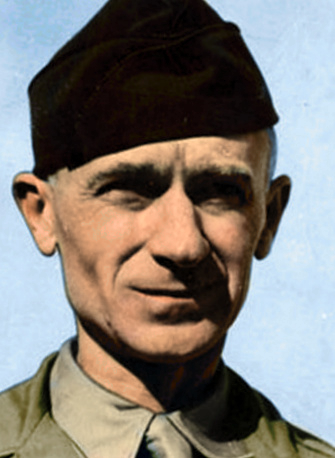The Free Lance-Star (July 5, 1944)
YANKS REACH LA HAYE-DU-PUITS
Battling foe in city’s streets today
Actions flare up on British front
SHAEF, England (AP) –
Doughboys fought hand-to-hand late today through the streets of La Haye-du-Puits, German anchor on their western flank in France, after seizing the railway station 300 yards from the heart of that important junction town.
Besides battering into La Haye-du-Puits, Lt. Gen. Omar N. Bradley’s men scored advances of more than two miles along the entire front near the town, six miles inland from the western coast. A field dispatch said the railway station fell shortly after 9:00 a.m. (local time).
The Germans counterattacked with infantry and tanks, throwing in giant Tiger tanks for the first time on the U.S. sector in Normandy in a vain effort to save the town, the dispatch added.
Violent fighting also flared at the eastern end of the front near Caen. Field Marshal Erwin Rommel attacked heavily against the lower tip of the British wedge southwest of Caen, seeking to break through the Allied line. Canadian troops were forced back in the battle for Carpiquet Airfield, due west of Caen.
SHAEF, England (AP) –
The U.S. 1st Army has battled the Germans out of 17 villages and hamlets in its explosive assault down the Cherbourg Peninsula during the past 24 hours, driving the Germans back to within one mile of La Haye-du-Puits, western anchor of Nazi defenses in Normandy.
On the eastern extreme of the bridgehead front, Canadians fought hand-to-hand today with stubbornly resisting Germans for Carpiquet Airfield three miles from Caen, while the British to the south beat off new German tank attacks with heavy enemy losses.
Lt. Gen. Omar N. Bradley’s tireless U.S. doughboys, attacking in a jagged 20-mile arc from Carentan to the west coast of the Cherbourg Peninsula, advanced from a half-mile to two-and-a-half miles in swampy, canal-creased country.
Six-road junction
U.S. columns converging on La Haye-du-Puits, an important six-road junction, were within two miles of the town on the west, three miles on the north, a mile on the northeast and three miles on the east. Capture of the town appeared imminent.
Progress was far from easy. The Germans resisted heavily in all sectors, and a particularly violent engagement was going on a half-mile south of newly-captured Saint-Jores, east of La Haye.
The long-quiet Carentan sector erupted into bloody fighting when the Americans launched an attack down the Carentan–Périers road. The doughboys advanced half a mile in an attack starting at noon yesterday.
Each foot of the advance had to be covered with artillery. Swamps and canals channelized the fighting to the narrow area along the road.
On the Carentan–Tilly-sur-Seulles sector of the front, there was only patrol activity.
East of Gavrus, at the butt of the Odon River bridgehead, the Germans launched a night counterattack, but it was smashed by Gen. Bernard L. Montgomery’s big gun batteries. Another similar attack to the south three hours later was also smashed.
Light opposition
The British advance which captured Verson, two miles below Carpiquet and four miles southwest of Caen, encountered only light opposition. But to the north, where the Canadians captured Carpiquet, three miles west of Caen, the Germans resisted violently and beat back all attempts to capture the airfield.
Field Marshal Gen. Erwin Rommel had tanks dug in on a ridge overlooking the airfield. These tanks swept the field with fire and even rocket-firing Typhoons failed to dislodge them. Digging tanks in to the turret is a device the Germans used with considerable success in Russia and at Cassino in Italy during the past winter.
Slightly improved weather allowed the Allies to put up over 3,500 planes in support of the bridgehead yesterday and at least 23 German planes were shot down.

